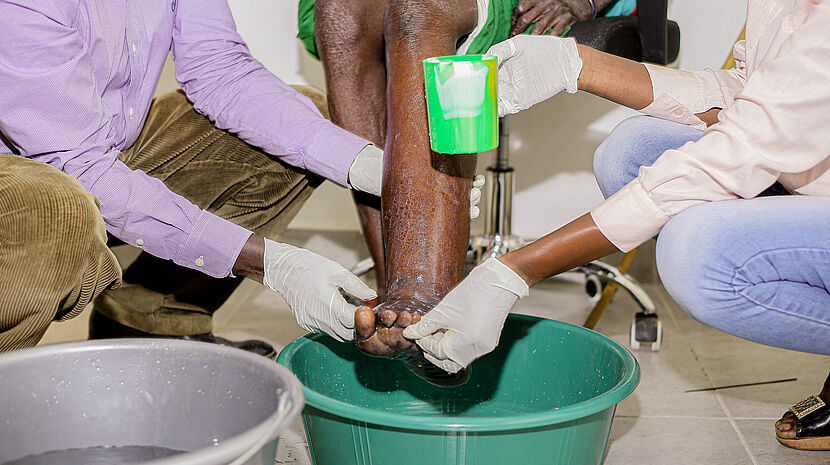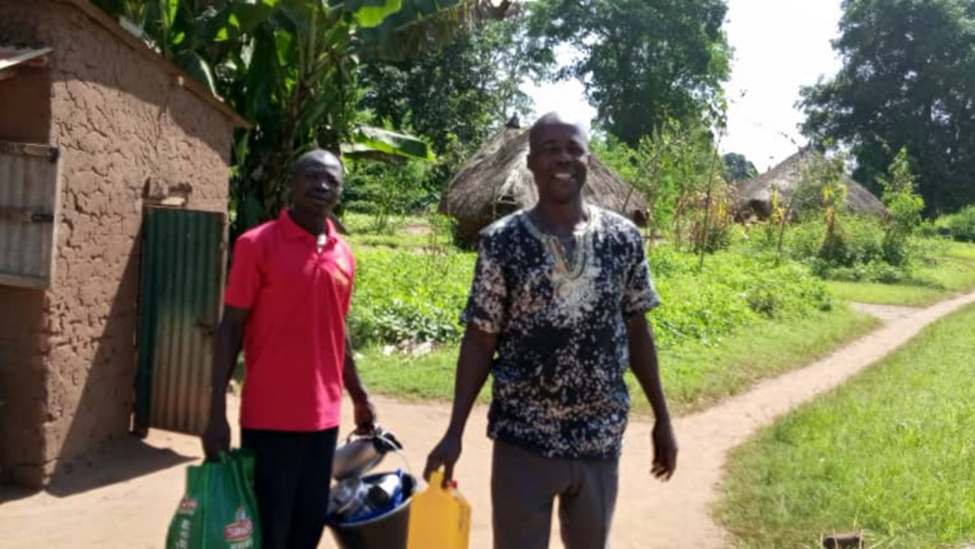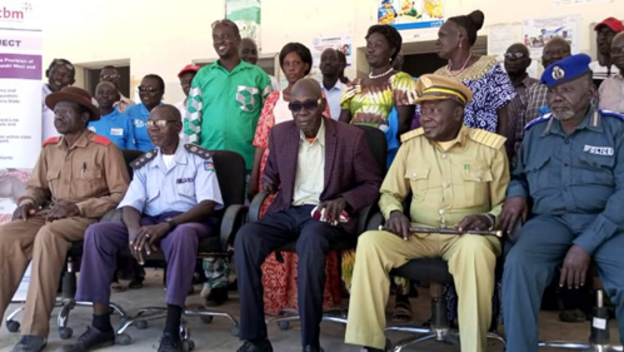Eliminating Barriers:
NTD Treatment Reaches Hard to Reach Communities

Healthcare workers offer primary care to a member of the community suffering from lymphoedema.
CBM
Challenges and successes in reaching remote communities in South Sudan affected by lymphatic filariasis, a debilitating NTD that affects around 40 million people worldwide.
Lymphatic filariasis (LF) is a parasitic infection caused by thread-like worms that enter the human lymph system through mosquito bites. If not treated, the painful and disfiguring manifestations of the disease, lymphoedema (swelling in the arms or legs), and hydrocoele (swelling of the scrotum) occur later in life and can lead to permanent disability. Affected persons are not only physically disabled but often also carry a mental burden, experience social exclusion, and suffer economic losses.
Approximately 40 million people worldwide suffer from manifestations of LF including lymphedema, and hydrocele. Timely treatment not only protects endemic communities from the disease but also reduces parasitic infections in the bodies of those already affected.
The WHO-recommended strategy to address the suffering caused by LF includes:
-
Mass drug administration
-
Surgery for hydrocoele,
-
Treatment for episodes of adenolymphangitis (ADL) and
-
Management of lymphoedema to prevent both the progression of the disease and episodes of ADL for every person with lymphedema or hydrocele available in all areas where LF is endemic.

John Muthesi is a community member from Bahr ulo Payam, Maridi District, Western Equatoria State, who is participating in the hydrocele surgery campaign. Here he is accompanied by a family member to a health facility.
CBM
John Muthesi, a 34-year-old farmer from Bahr ulo, Maridi County in Western Equatoria state, South Sudan has been suffering from hydrocele since 2015. Living in a remote area with limited access to healthcare, John felt helpless, attributing his condition to a curse, or perhaps stepping on a poisonous substance. This disabling symptom not only hindered his social life but also impeded his ability to engage in economic activities.
Launch of the LF MMDP Project
In collaboration with the Ministry of Health (MOH), CBM together with partners including, AMREF, CUAMM, and ONO AID, launched the Lymphatic Filariasis Morbidity and Disability Prevention (LFMMDP) project aimed at combating the disabling effects of lymphatic filariasis (LF) in South Sudan. The initiative brought together a diverse group of stakeholders, including local chiefs, religious leaders, health officials, administration officers, NGOs, and community members, setting the stage for collaborative action.
The project's objective is clear: to contribute to the elimination of lymphatic filariasis and increase access to lymphedema and hydrocele patient care for affected community members in four targeted counties — Maridi, Ibba, Mundri East, and Mundri West in Western Equatoria state as the initial stage of a countrywide programme. In the context of South Sudan, the project encountered some challenges including poor infrastructure, limited hospital capacity, poor road networks, weak communication networks, and limited resources for mobilization and awareness raising in affected communities. Yet, the project successfully identified and provided surgeries to affected persons and delivered a minimum package of care to an estimated 63 community members experiencing lymphedema across the four districts. This is a major advancement in our efforts to reduce suffering and stigma from lymphatic filariasis-related disabilities.

Key stakeholders at the launch of the LF MMDP Project
CBM
Key activities of the LF MMDP project included the development of training materials for hydrocele surgeries and lymphedema patient care, social mobilization, training of health workers and community members on lymphedema management, training of surgical teams, identification of affected persons, distribution of self-care hygiene kits to affected persons, surgery to hydrocele patients, and establishment of supportive supervision systems. These activities contributed to the strengthening of existing health systems for the provision of LF MMDP services.
John, who heard the news of the free surgical services for people affected by hydrocele from the chief of his village, was one such participant in the project. Bracing the challenge of the poor roads, John made it to the neighboring village where he received free surgical treatment.
John can now move freely within his village, participate in cultural events, fulfill social duties and economic activities he had long set aside.
I am so glad that the ministry and its partners thought of us; now they have corrected my body. I can move freely in my community and participate freely in cultural events. I promised myself that after recovery, I will dance to compensate for the years I was unable to dance.John Muthesi, community member who participated in the LF MMDP project.
A Sustainable Approach for Health System Strengthening
A primary objective of the project is to support the MOH efforts to strengthen the health system at the community level by increasing the capacity and access to hard-to-reach community members and training community health workers, who provide a first line of primary healthcare. In addition, the MOH launched the One Health agenda, fostering collaboration with various stakeholders. This inclusive approach involves partnering with other ministries, existing programmes, and the private sector, providing the opportunity for community members who have received surgical treatment in Western Equatoria state to be connected to other services, such as livelihood programmes, to enhance their overall well-being.
Plans are underway to expand LF-MMDP to the remaining six counties of Western Equatoria state in 2024, marking a significant step forward in our mission to reduce suffering and stigma from NTDs like lymphatic filariasis n South Sudan.